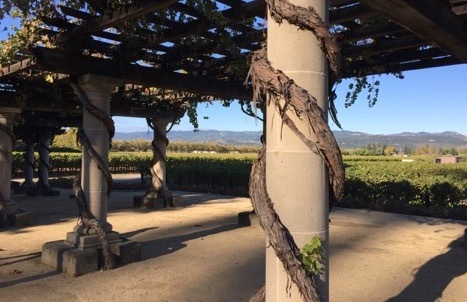Napa Valley and Sonoma Valley wineries are open and back in business, welcoming visitors to their vineyards and tasting rooms. The smoke has cleared, the air is clear, and the vines are showy in their fall colors.
In early November, which is usually a fairly busy season, wineries, resorts, and restaurants were reporting visitor numbers off by 75% or more. But as the "open for business" message spread, there have been signs of slow recovery.
Tourism is essential to the economy in Napa and Sonoma wine country, located just an hour north of San Francisco. Visitors who stick to the established winery trails will encounter few traces of the damage done by fast-moving, windswept flames that produced a humanitarian crisis in the more developed areas nearby.
Touring After the Fires
A little over 5% of the the land in Napa, Sonoma, and Mendocino counties burned. Blackened sections of forested land can be spotted in the distance from the main roads along the top of the Mayacamas Mountains to the west and north of Napa Valley. Locals point to spots where fires jumped across a highway or claimed Sonoma’s 100-year-old Stornetta Dairy and its Bee-Well Farms.
But fortunately in wine country, the fires were mostly contained to the wooded hillsides. In the valleys, the vines tend to be planted in such a way as to slow fire’s spread, and they hold enough moisture in early fall to serve as firewalls throughout most of wine country’s acres. Most barrelled vintages were stored in places where the smoke did not reach.
Out of around 600 wineries and tasting rooms in the region, only about 27 suffered notable damage, and most of those suffered loss to landscaping and outbuildings rather than to the core structures that welcome visitors.
Some exceptions in Sonoma include the beautiful Paradise Ridge and Ancient Oak Cellars; in Napa the less fortunate wineries include Signorello Winery, Helena View Johnston Vineyards, and the smaller Oster Cellars, Sill Family Vineyards, and VinRoc. Backbone Vineyard in Mendocino County was also ruined.
Most of those were not major tourist stops, and some, like Paradise Ridge, maintain tasting rooms or vineyards located away from the damage so they can keep going or start over.
The Hilton Sonoma Wine Country Hotel in Santa Rosa was close to a developed area and it burned down, but most other hotels remain unaffected.
Sonoma’s Gundlach Bundschu Winery, California’s oldest family-owned winery, was also spared, as were the popular tourist stops of Robert Mondavi, Charles Krug, Beringer Wines, and Inglenook (pictured this month, above).
Recovery has been swift. At Darioush Winery on the Silverado Trail, much of the landscaping has already been replanted, although several singed olive trees and a circle of blackened palm trees stand as testament to the proximity of the flames. Inside the cellars, a slightly smoky smell is still noticeable, but there are high hopes for the stored vintages.
At Domaine Chandon in Yountville, a popular stop on many tours, visitors still enjoy hilltop sunshine on Adirondack lawn chairs. At this estate, where premium sparkling wine is created by the luxury French Champagne house Moët et Chandon, the only mention of smoke was the smoked salmon hors d’oeuvres served to accompany a flute (or two) of bubbles being poured for guests on tour.
Francis Ford Coppola’s Inglenook Winery continues to host multiple tours simultaneously, and the tasting rooms and gift shop are still bustling with tourists.
Many vintners are donating some or all of their tasting fees to local disaster relief charities.
Flavor Matters
The visitor experience in Northern California’s prime wine country hasn’t dramatically changed, but that doesn’t negate lingering concerns about the future of wine production and tourism that are the lifeblood of the region.
Due to smoke taint that may have been suffered by 10–15% of the grapes still on the vine (mostly cabernet sauvignon and merlot), some growers have opted to discard that portion of their fruit, while others await test results on these thick-skinned red grapes.
Additional reporting by Jason Cochran






